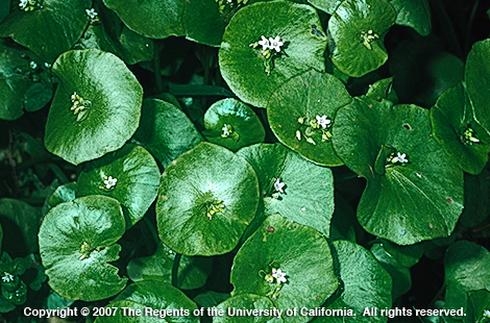Mar 14, 2013
Weeds are such an expected part of any garden. They come, you weed, they come, and you weed again, and again, and again. So imagine my surprise when my husband became upset at my weeding out this lovely little green leafed weed each winter. "That is miner's lettuce" he yelled. "It is delicious!" he yelled louder.
"But it is a weed, and it seems to be taking over," I countered.
"Taste it." he countered my counter.
I did, ever so hesitantly, as I am not accustomed to eating weeds. Much to my surprise, I tasted a sweet, mild, spinach like green. And even more to my surprise, I liked it.
Since that time, throughout the winter and into early spring, we start each day with our green smoothie, and miner's lettuce is the predominant green ingredient added.
So just what is this weed/green/plant wonder?
Claytonia perfoliata, miner's lettuce, winter purslane, or Indian lettuce is an annual plant native to the western mountains and coastal regions of North America, but most common in California in the Sacramento and northern San Joaquin valleys.
It gained its name through the miners during the California Gold Rush eating it, thereby getting their vitamin C and preventing scurvy. It has been reported that early explorers saved the seeds and brought them back to Europe to grow, first as a curiosity, then as a food plant. Miner's lettuce was so important as a source of vitamin C that the British planted it in Cuba, and later, in Australia. By that time, it was growing spontaneously in the Botanical Gardens of Paris, and being sold as a salad green and potherb, but by mid-century was considered a weed in Britain.
I have known for some time that America has very few native natural foods--wild turkey, the Jerusalem artichokes and cranberries. Now I can add miner's lettuce to that list.
It is unclear why miner's lettuce is not more know, more used, more available. It is tasty, easy to grow, full of vitamin C, vitamin A, and iron. However, it is not to be found at the Farmer's Market or any market that I know of. Many view it as simply a weed, though seeds can be easily purchased for home gardening. It is found on our own IPM website in the Weed Photo Gallery. (Isn't the definition of a weed, a plant you do not want?)
However, if you are wanting to start this crop in your own garden, as I said, seeds can be purchased through most gardening catalogs. But let me warn you. If you decide to grow it, it tends to be very invasive and will eventually take over your winter garden. Each winter, our crop increases, and we do nothing to make this happen. We have not minded.
When eaten, it is primarily consumed raw in salads. For those who juice or drink green smoothies, it can be a winter staple. Or it can be cooked or steamed much like spinach. A friend of mine who has just discovered this green wonder said she mixed it in an egg scramble, using it much like she would have spinach. She reported that it was delicious.
Healthy, crisp leaves, free from blemishes or signs of degradation and irregularities such as wilt, can be stored in the refrigerator for up to one week by placing the greens in a sealable storage bag with a moistened paper towel. Do not place it near fruits or vegetables that produce ethylene gases, as that will produce early spoilage.
It is commonly found growing in late winter after the first heavy rains and continues through early spring. As the days get hotter, the leaves turn a deep red color as they dry out.
Call it a weed if you'd like, but miner's lettuce has a home at our house.
